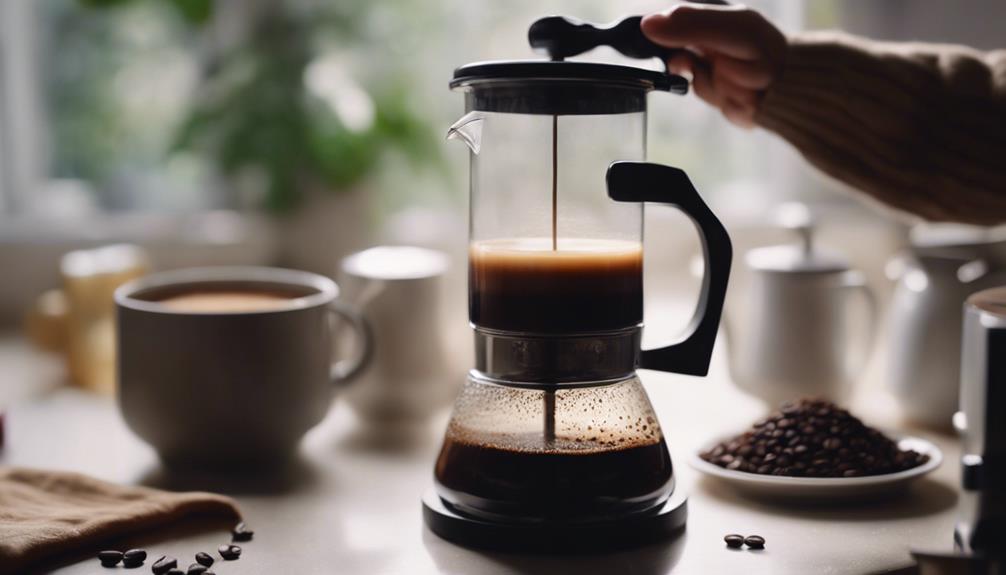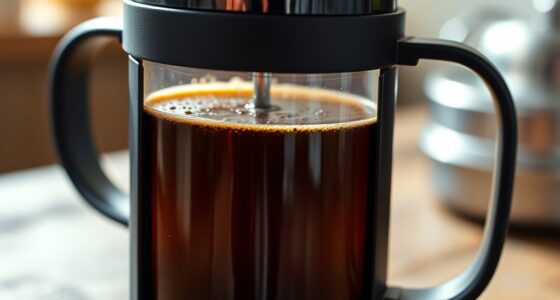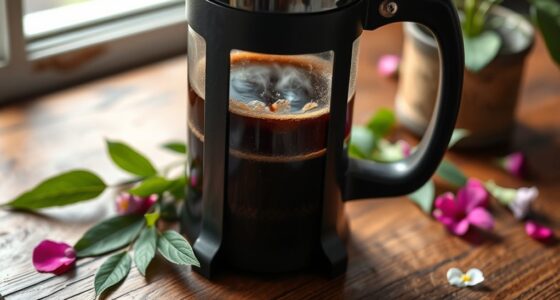When choosing between light and dark roast for your French press, expect distinct differences. Light roasts deliver brighter, fruity flavors with nuanced notes and slightly more caffeine, but may require a longer steep and careful extraction. Dark roasts provide bolder, smoky tastes with a fuller body and shorter brewing time, making them more forgiving. Understanding these contrasts helps you find your perfect brew—continue exploring to discover how roast choices can shift your coffee experience.
Key Takeaways
- Light roasts offer brighter, fruity, and floral flavors with higher acidity, while dark roasts have bolder, smoky, and caramelized notes.
- Light roasts tend to be more delicate and may need longer steeping for full extraction; dark roasts extract quickly and are more forgiving.
- Light roasts generally contain slightly more caffeine than dark roasts, but brewing method impacts caffeine extraction significantly.
- Dark roasts provide a fuller body and intense flavor, whereas light roasts highlight subtle origin characteristics and nuanced flavors.
- Both roasts work well in a French press; personal preferences and experimentation can help determine the ideal choice.

When choosing between light and dark roast coffee for your French press, understanding how each roast impacts flavor and brewing results can help you make the best choice. Light roasts tend to have brighter, more nuanced flavor profiles that highlight the coffee’s origin characteristics. Expect notes of fruit, floral tones, and a lively acidity that makes each sip feel vibrant. These roasts preserve more of the beans’ original qualities because they’re roasted for a shorter time, which means you experience a wider range of subtle flavors. On the other hand, dark roasts develop a bolder, more robust flavor with smoky, caramelized notes. They often have a fuller body and a more intense taste, which can overshadow delicate origin flavors. The choice largely depends on your flavor preferences—whether you lean toward the complex brightness of a light roast or the deep, smoky richness of a dark roast.
Caffeine content is another factor to contemplate. Contrary to popular belief, light roasts generally contain slightly more caffeine than dark roasts. During the roasting process, caffeine levels decrease very gradually, so the shorter roast preserves more of the bean’s caffeine. However, the difference isn’t enormous, and brewing method plays a significant role. When using a French press, the full immersion technique extracts more caffeine from the coffee grounds regardless of roast level. This means that your cup will pack a caffeine punch whether you opt for light or dark roast, but if caffeine is your priority, a light roast might give you a marginal edge. Additionally, understanding how spiritual energy can influence your overall well-being can help you approach your daily routines with mindfulness, even during coffee preparation.
Brewing results also differ based on roast choice. Light roasts tend to be more delicate and can sometimes be under-extracted if you don’t adjust your brewing parameters, such as grind size and steep time. They often require a slightly longer steep to fully develop their flavors. Dark roasts, with their oils and richer surface, tend to extract more quickly and can handle a shorter steep time without losing flavor. This can make dark roasts more forgiving for beginners or those looking for a consistent brew without fine-tuning.
Ultimately, your decision comes down to your taste preferences and caffeine needs. If you love a bright, complex cup with a caffeine boost, go for a light roast. If you prefer a bold, smoky flavor with a smooth body, dark roast is the way to go. Both can be excellent choices in a French press, and experimenting with different roasts will help you discover what suits your palate best.
Frequently Asked Questions
How Does Roast Level Affect Caffeine Content?
Roast level influences caffeine variability, but not as much as you might think. Light roasts generally have slightly more caffeine because they undergo less roasting, preserving more of the beans’ original caffeine content. Dark roasts may seem stronger but often contain a bit less caffeine. So, your choice affects alertness; if you want a caffeine boost, opt for a light roast. However, brewing method and bean type also play vital roles.
Which Roast Type Preserves More of the Coffee’s Original Flavor?
You’ll find that light roasts preserve more of the coffee’s original flavor because their shorter roasting process highlights the bean origin’s unique characteristics. The beans retain more of their natural acidity and nuanced notes, giving you a brighter, more complex cup. Dark roasts, with their extended roasting, tend to mask these original flavors, emphasizing roasted and smoky notes instead. So, if you want to taste the bean’s true essence, opt for a light roast.
Are Certain Roasts Better Suited for Specific Brewing Times?
You’ll find that certain roasts respond better to specific brewing times. Light roasts, with their delicate flavors, benefit from a shorter brewing time to prevent over-extraction, while dark roasts can handle longer steeping. During the blooming process, a coarser grind helps prevent over-extraction, especially for darker roasts. Experiment with grind size and brewing time to find your perfect balance, ensuring each roast type brings out its best flavor.
How Does Roast Choice Influence Acidity in French Press Coffee?
You’ll notice that your roast choice greatly influences acidity in your French press coffee. Light roasts tend to have a more acidic flavor, offering bright and lively notes, while dark roasts often bring out roast bitterness and smoother, less acidic profiles. If you prefer a sharper, tangy taste, go for light roast. For a richer, mellow experience, dark roast minimizes acidity and roast bitterness.
Can Roast Level Impact the Longevity of Coffee Freshness?
Did you know that dark roasts retain freshness longer than light roasts? Your choice of roast level can considerably impact storage life and freshness retention. Dark roasts have fewer oils and less surface area exposed, making them less prone to staling. To maximize freshness, store your coffee in an airtight container away from light and heat, ensuring your brew stays flavorful for as long as possible.
Conclusion
Choosing between light and dark roast in your French press is like picking a favorite song; it all depends on your mood. Light roasts offer brighter, more nuanced flavors, while dark roasts deliver bold, smoky notes. Experiment to discover what suits your taste buds best. Whichever you choose, remember that each brew is a journey—like a sunrise or sunset, it’s all about what you enjoy most. Happy brewing!









